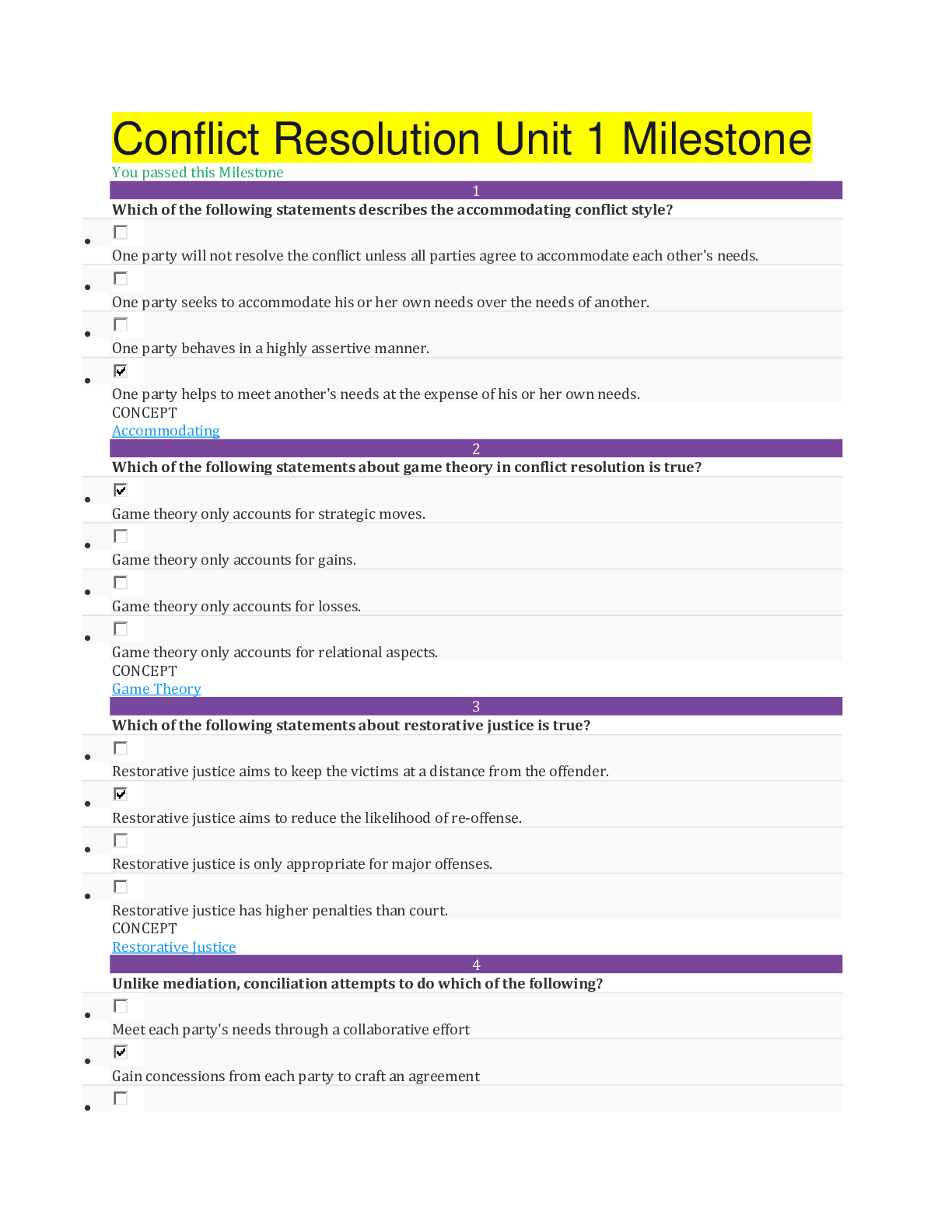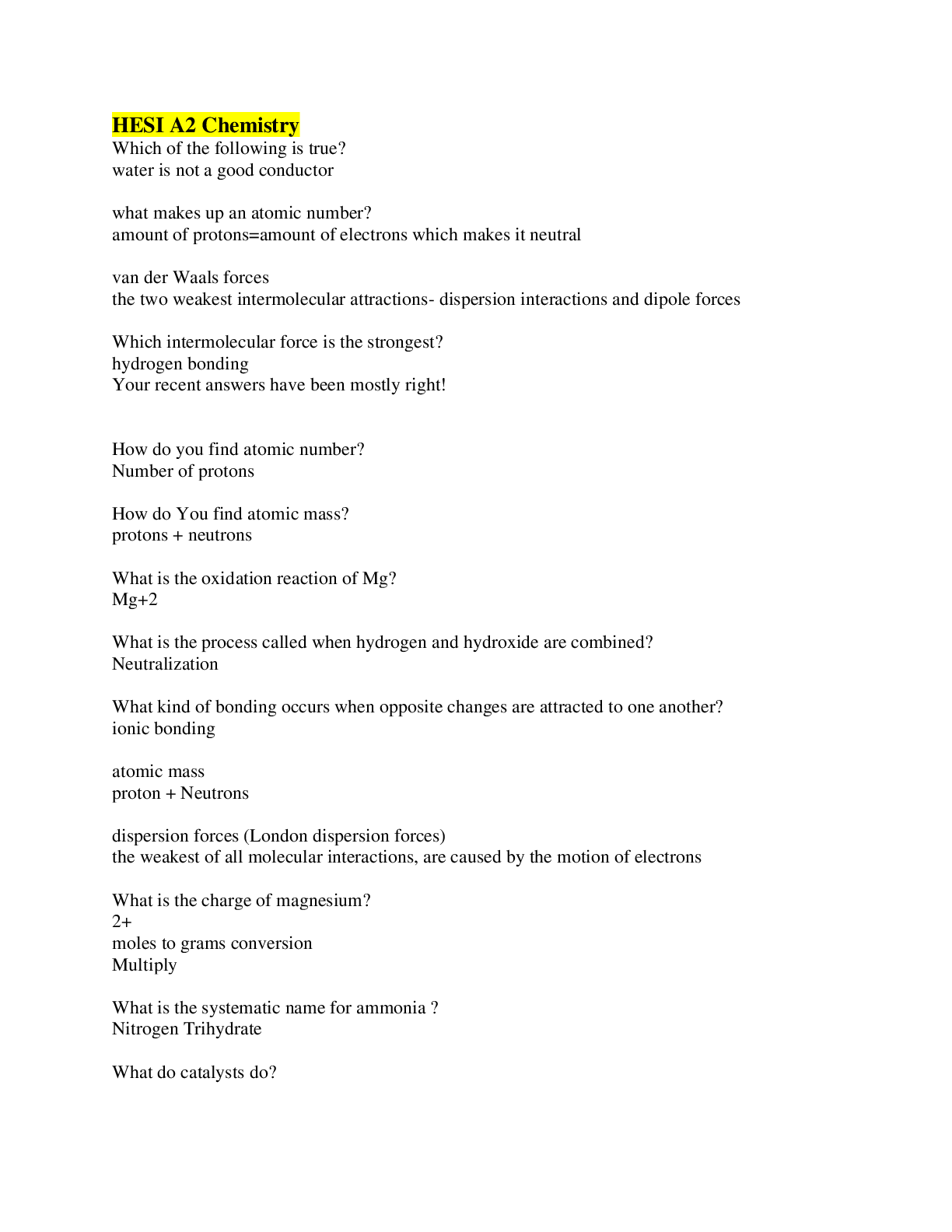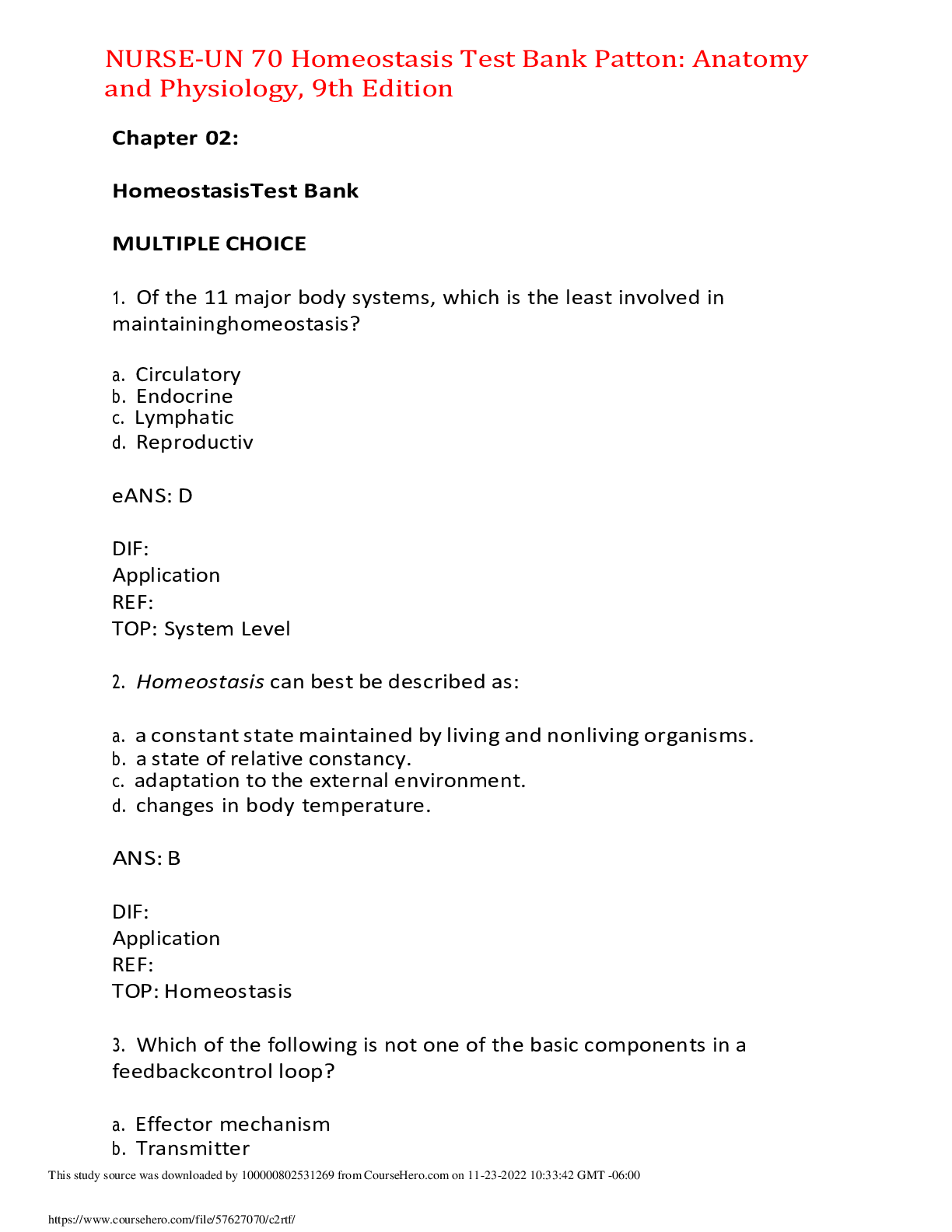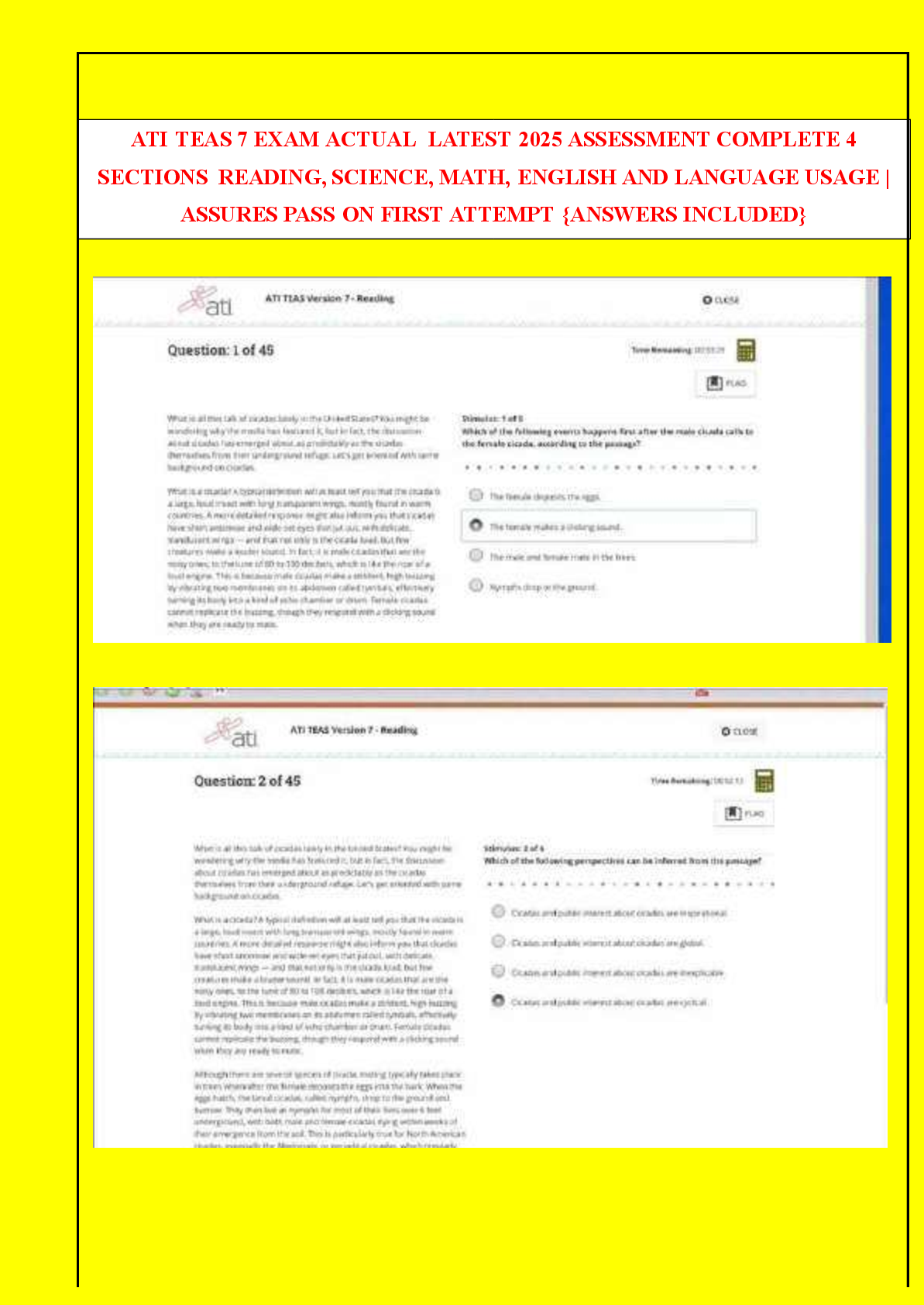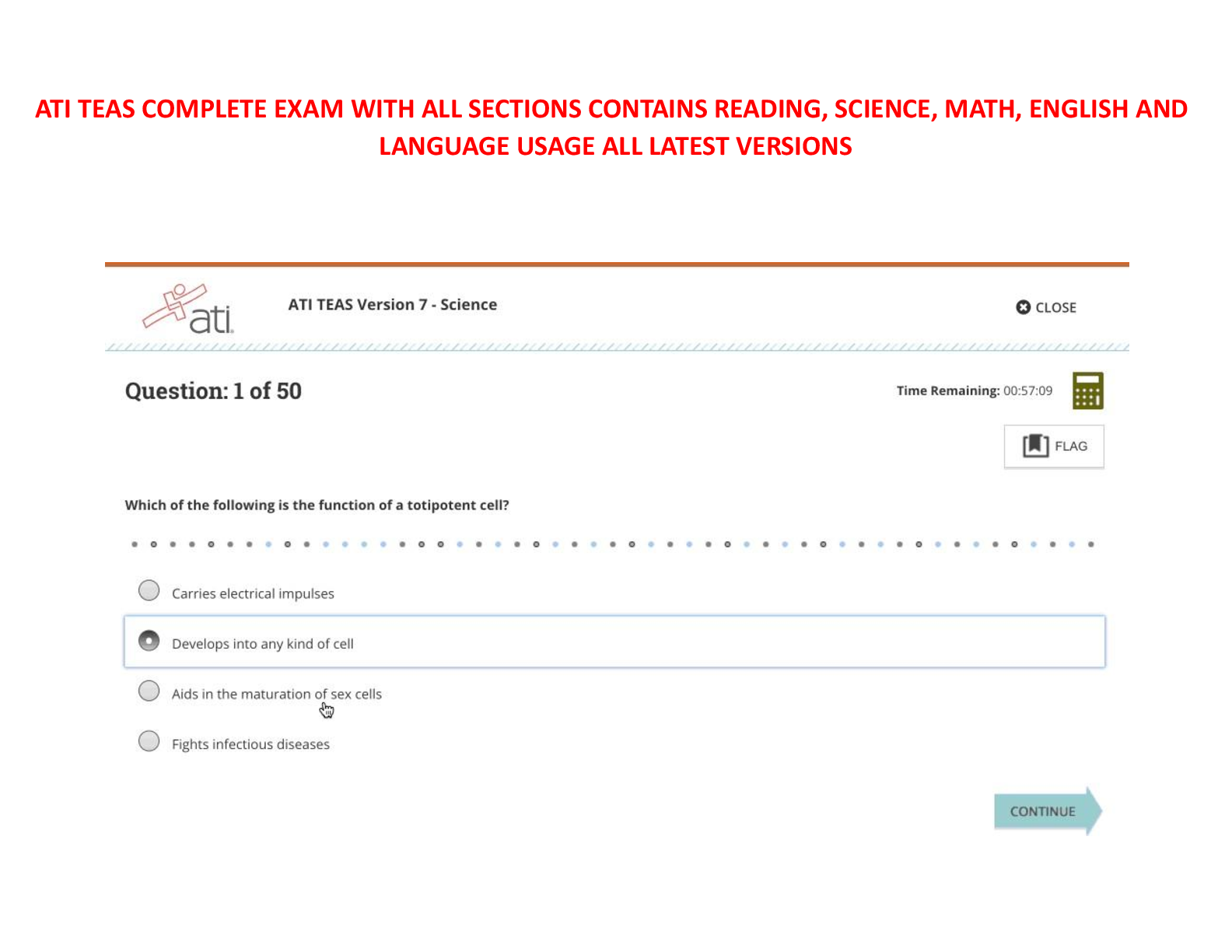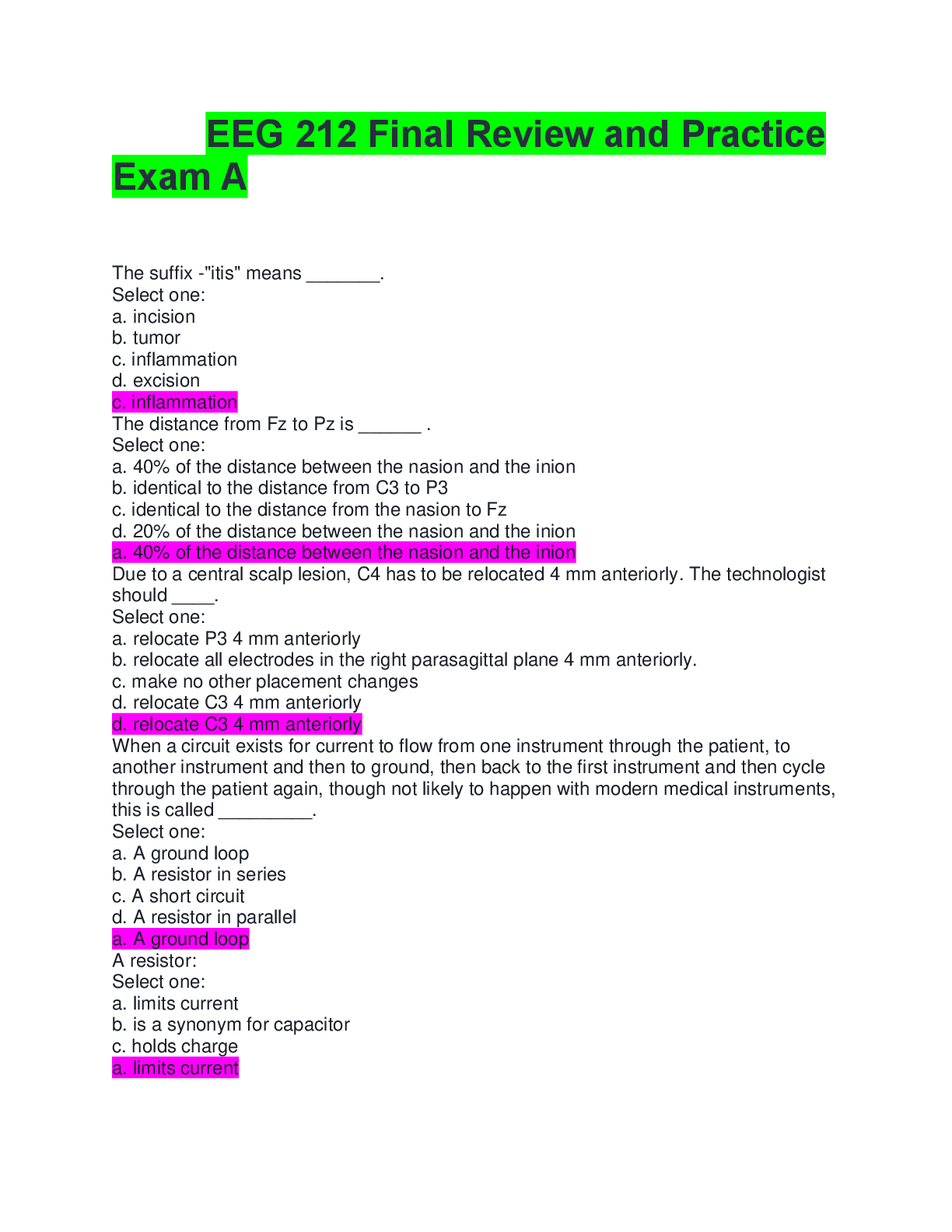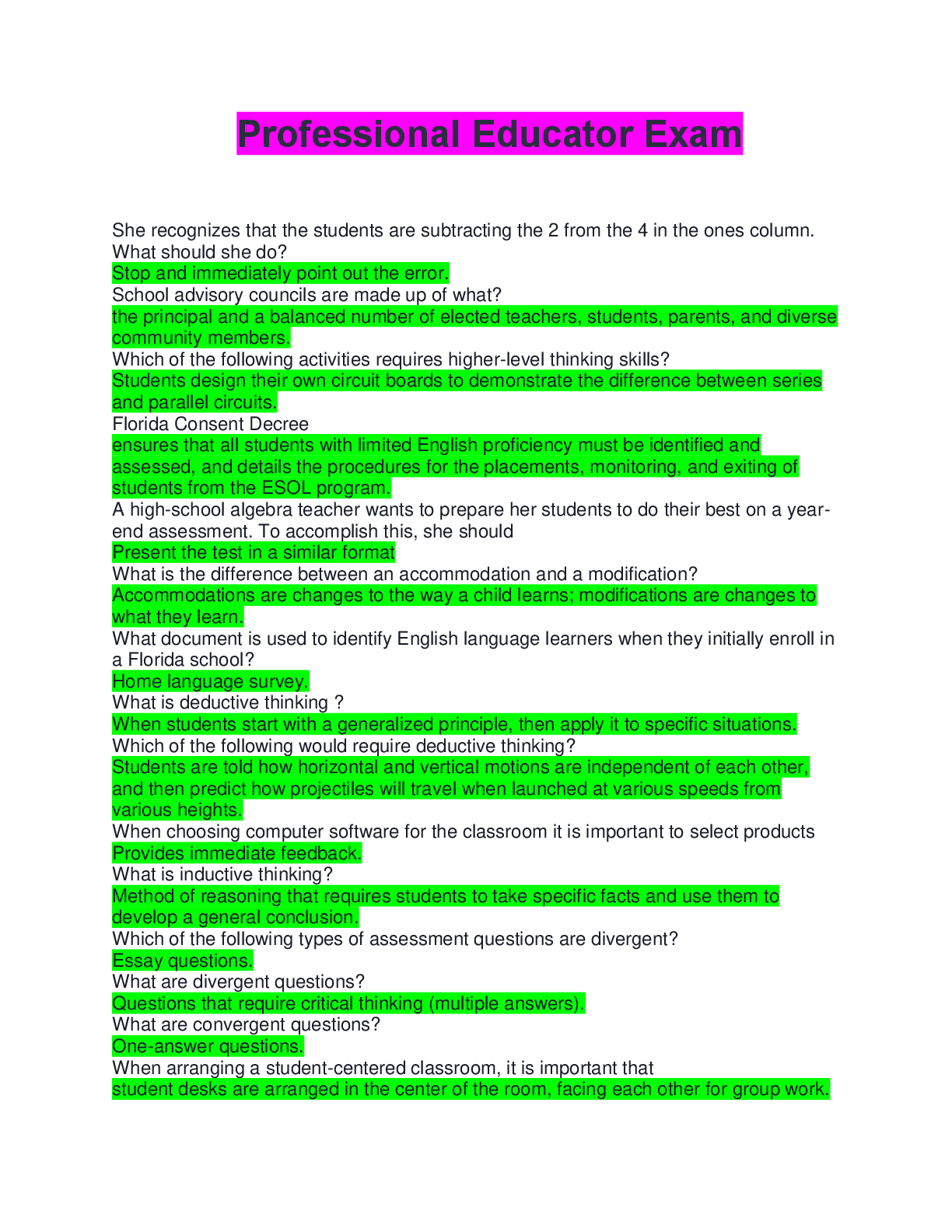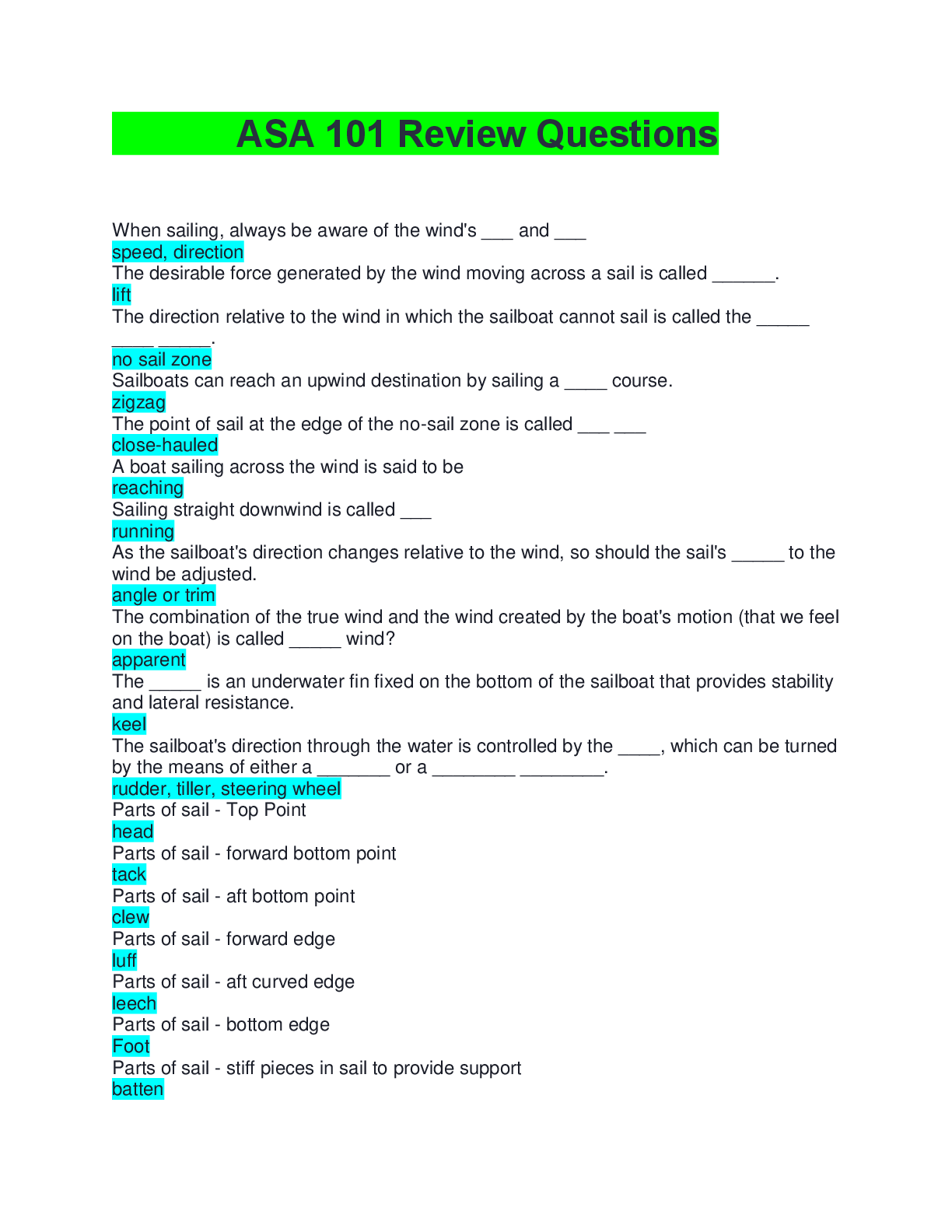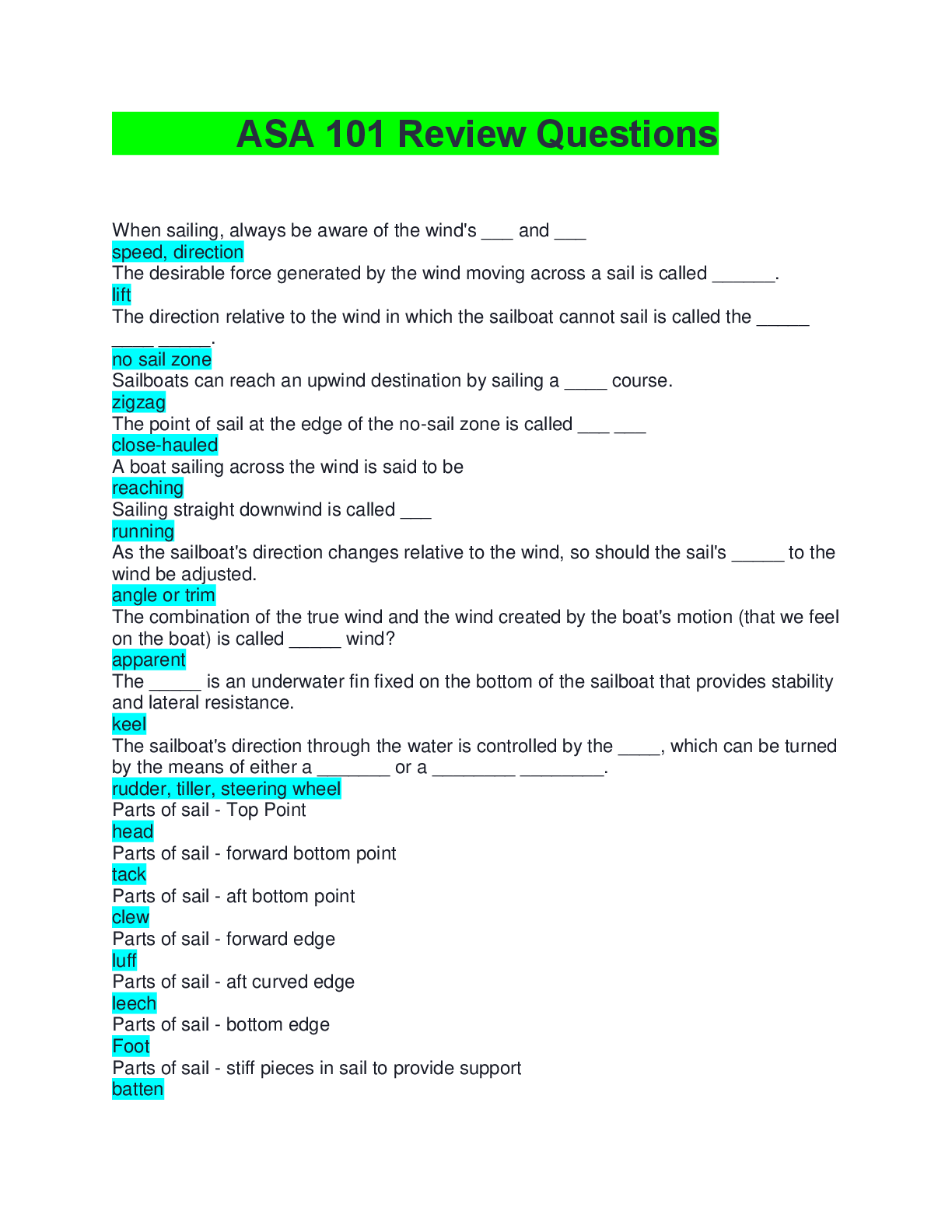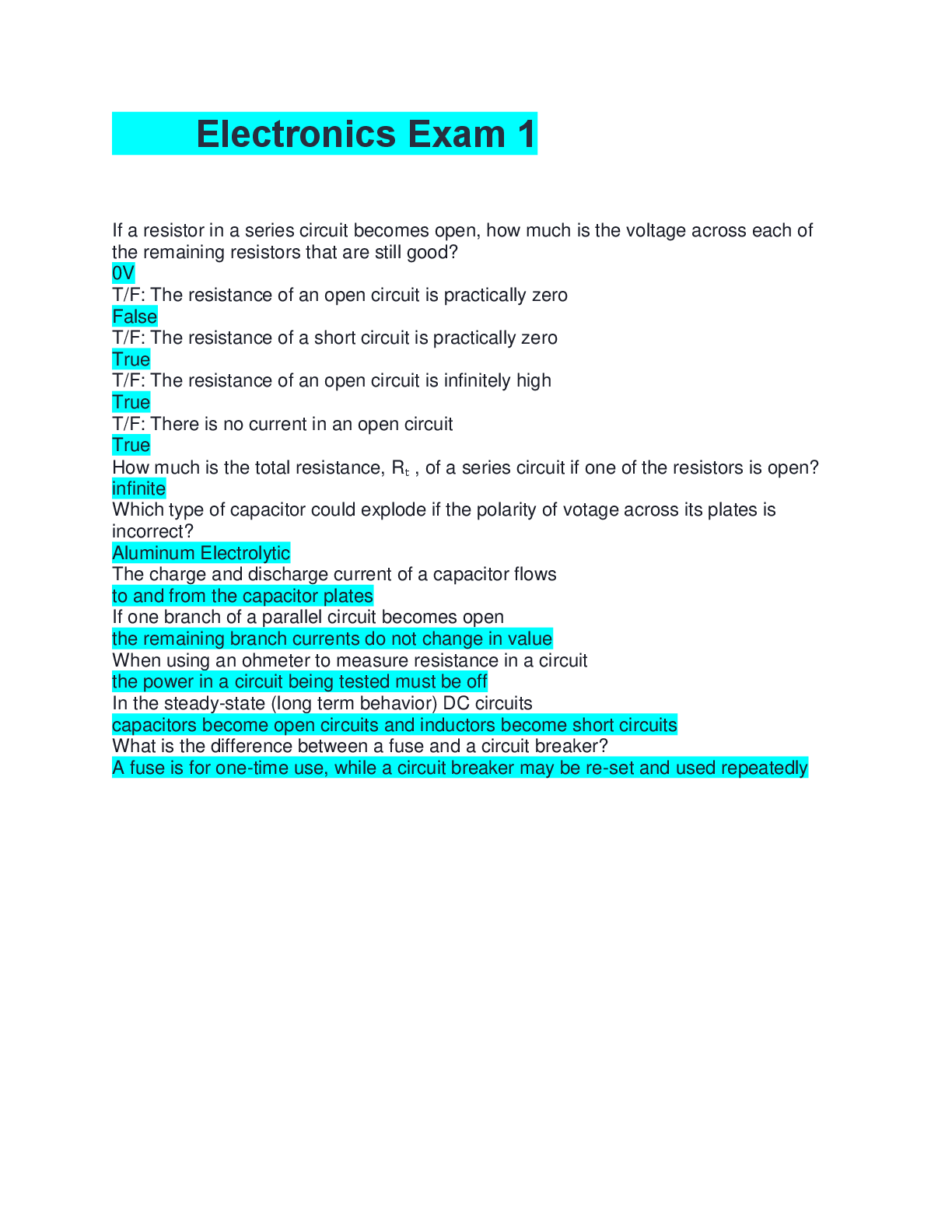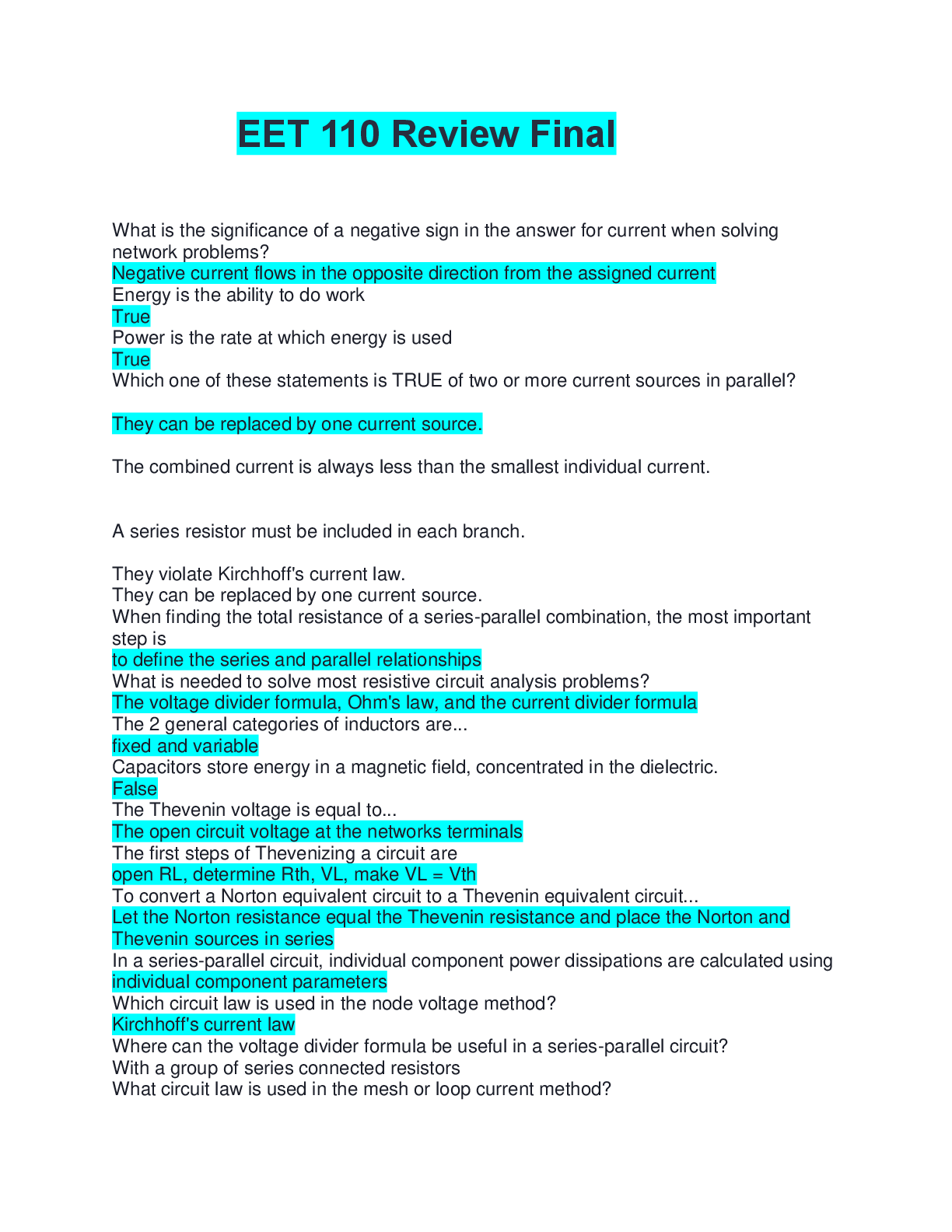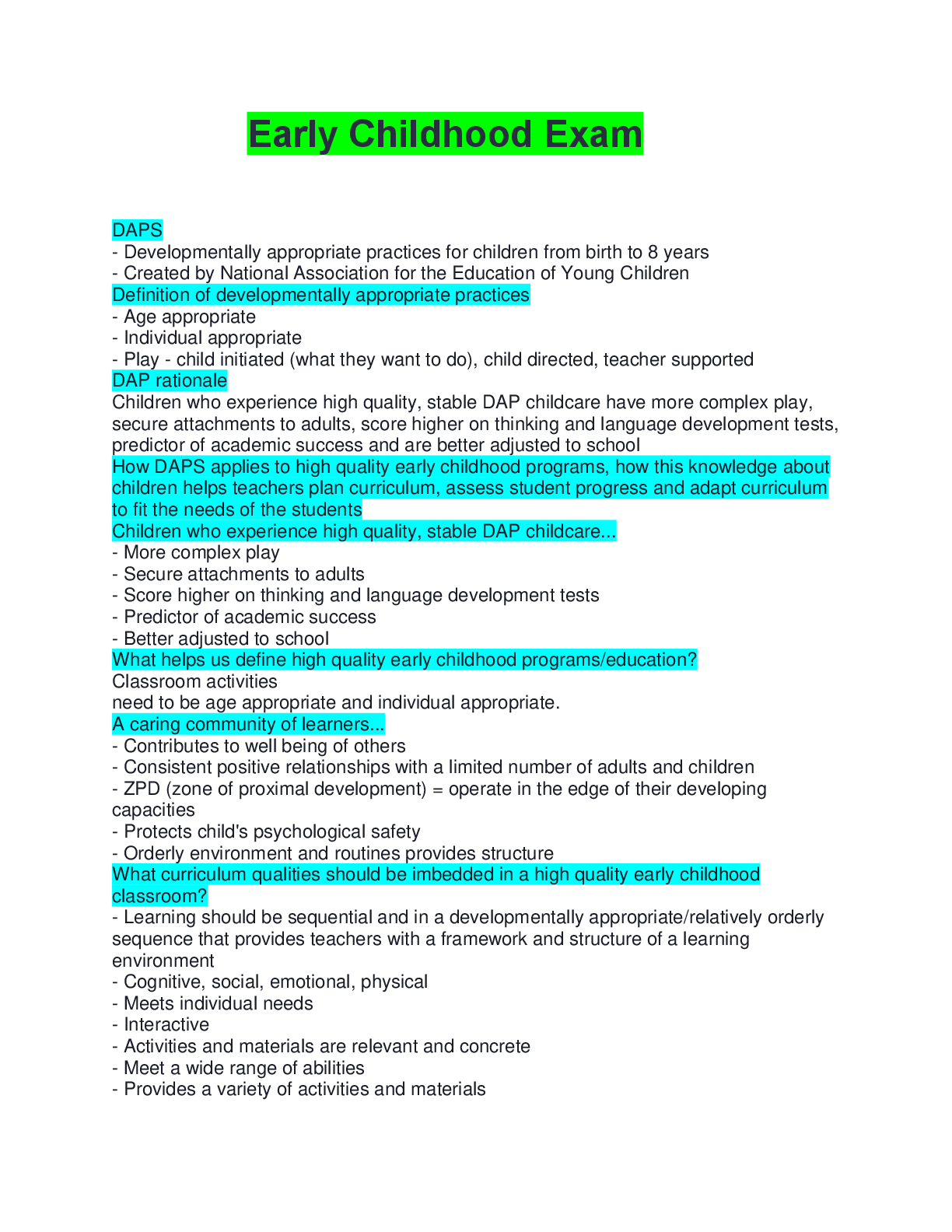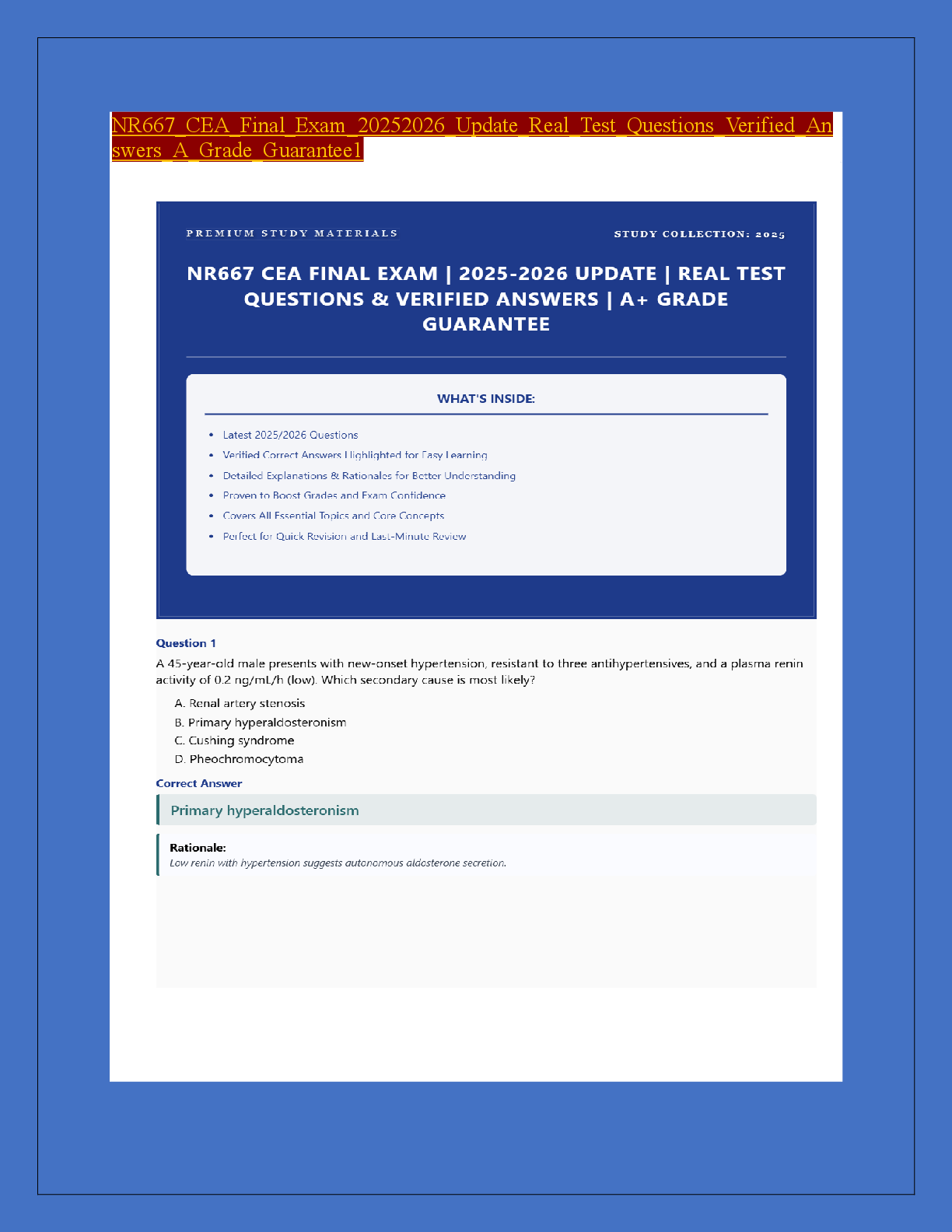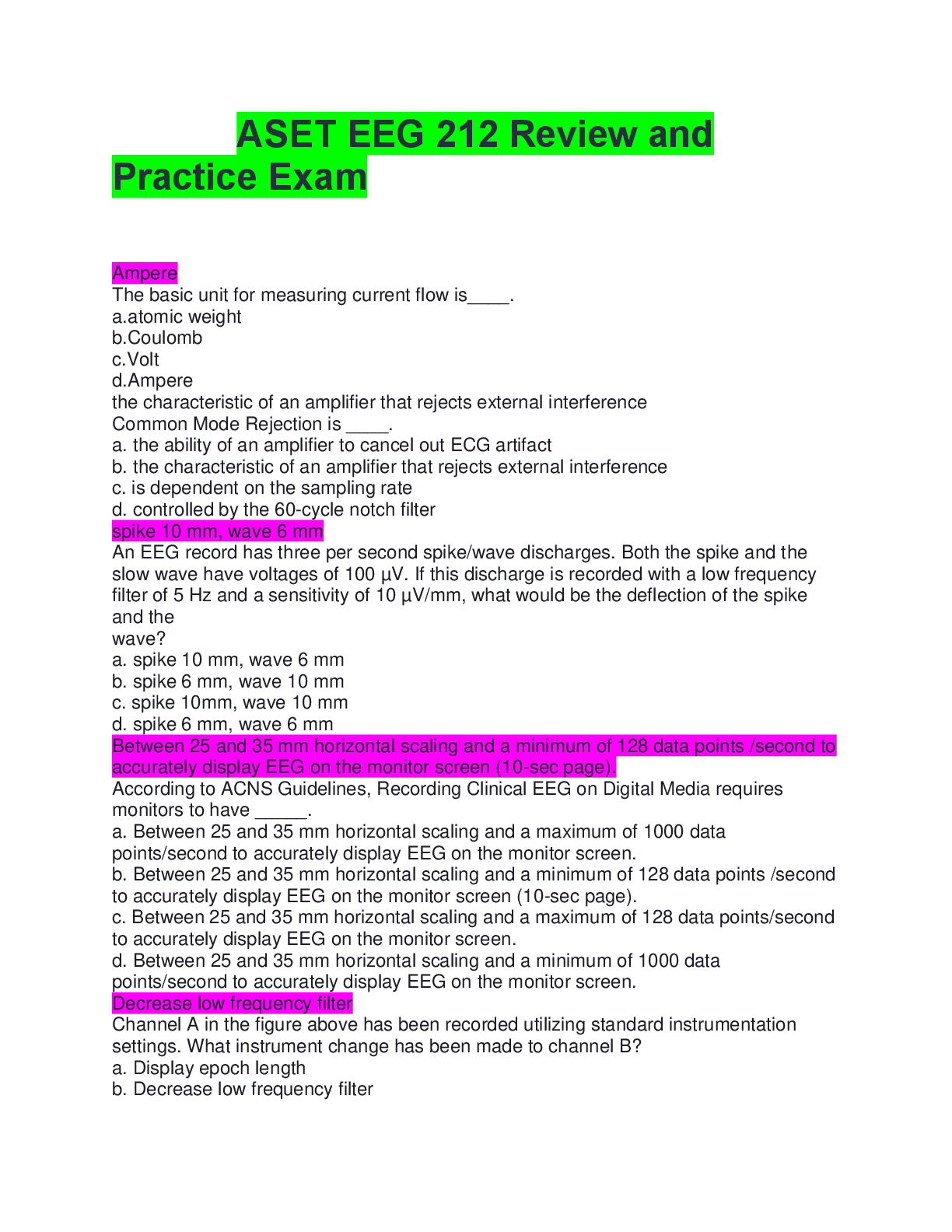ATI_Notes_Test_A Questions And Answers (Rated A)
Document Content and Description Below
ATI Test A. A nurse is reinforcing teaching about home safety with the parent of a toddler. Which of the following parent statements indicates an understanding of the teaching? - The nurse should i ... nstruct the parent to place a screen in front of a fireplace or other heating appliances to prevent burns A nurse is reinforcing teaching with the parent of a child who has hemophilia and is experiencing acute hemarthosis. Which of the following instructions should the nurse include in the teaching? - The nurse should reinforce with the parent to keep the child’s affected joints elevated and immobilized to minimize bleeding. After the acute episode, the child should begin active range-of-motion exercise. A nurse is collecting data about the dietary habits of an adolescent client. The nurse should identify that which of the following findings puts the client at risk for nutritional deficits? - The nurse should identify that adolescents are often at risk for developing poor eating habits. Skipping dinner twice each week puts this client at risk for nutritional deficits. A nurse is assisting with the care of a child who has tonic-clonic seizures. Which of the following actions should the nurse take? - The nurse should have a suction canister and tubing available in the child’s room to keep the child’s airway patent during a seizure. A nurse is reinforcing home safety instructions with the parents of a toddler. Which of the following parent statements indicates an understanding of the teaching? - The nurse should instruct the parents to turn pot handles toward the back of the stove to prevent the toddler from pulling a pot off the stove, resulting in a burn. A nurse in a pediatric clinic is collecting data from an infant who recently started taking digoxin. Which of the following manifestations should the nurse identify as an indication of digoxin toxicity and report to the provider? - The nurse should identify that vomiting, especially unrelated to feedings, is a manifestation of digoxin toxicity and should be reported to the provider. A nurse is caring for a school-age girl who is being treated for frequent, severe urinary tract infections (UTIs). The nurse should recognize that which of the following statements by the parent indicates a possible cause of the UTIs? - My daughter has bowel movements every 4 to 5 days—the nurse should recognize that this frequency indicates the child is constipated. Therefore, large stool masses might prevent complete emptying of the bladder and lead to urinary stasis and infection. A nurse is caring for a school-age child who has been admitted to facility in sickle cell crisis. The nurse is measuring the child’s oral intake for the shift. The child consumed 4 oz of juice at breakfast. For lunch, the child consumed 6 oz of milk, 6 oz of gelatin, and drank 7 oz of water. What is the child’s oral intake for this shit of milliliters. (Round to the nearest whole number.) - 1oz = 30 mL Client consumed 23 oz of fluids 23 oz X 30 mL = 690 mL A nurse is reinforcing dietary teaching with the guardian of a school age child who has celiac disease. Which of the following foods should the nurse recommend including in the child’s diet? - White rice—the nurse should reinforce to the guardian that celiac disease is a genetic autoimmune disorder in which eating gluten, even in a very small amounts, can damage the child’s small intestine. Currently, the only treatment for the disease is a lifelong, stick adherence to a gluten-free diet. The nurse should stress the importance of avoiding foods containing wheat, rye, barley, and oats. The child should consume foods that are gluten-free, such as milk, cheese, rise, corn, eggs, potatoes, fruits, vegetables, fresh poultry, meats, fish and dried beans. A nurse is reviewing the laboratory report of a preschooler. Which of the following laboratory results should the nurse report to the provider? - Lead 14 mcg/dL—the lead level is above the expected reference range for a preschooler. Therefore, the nurse should report this result to the provider. A nurse is reviewing the medical record of a female adolescent client who has primary amenorrhea. Which of the following findings should the nurse identify as a risk factor for this disorder? - Hypothyroidism - Cannabis - Oral contraceptive - Emotional stress A nurse is reinforcing teaching with the guardian of child who has scabies and a new prescription for permethrin 5% cream. Which of the following information should the nurse include? - The medication will eliminate your child’s itching within 2 to 3 weeks—the nurse should instruct the guardian that, although the medication kills the mites, itching can continue for 2 to 3 weeks following application of the medication. A nurse is preparing to administer ophthalmic drops to a child. Which of the following actions should the nurse take? - Apply pressure to the lacrimal punctum for 1 min following administration—the nurse should apply pressure to the lacrimal punctum to prevent the medication from entering the nasopharynx. A nurse is reinforcing discharge teaching with the parent of a school-age child who is being treated from nephrotic syndrome. The parent asks the nurse why it is necessary to check the child’s urine for protein. Which of the following explanations should the nurse offer? - A decrease in urine protein indicates that treatment is effective—the desired outcome of steroid therapy in the treatment of nephrotic syndrome is a reduction of proteinuria. A nurse is assisting the provider with a developmental assessment of a toddler. Which of the following behaviors should the nurse recognize as an expected finding? - Standing of one foot for several seconds is an expected behavior for a toddler. A nurse is collecting data from an infant who has severe dehydration. Which of the following findings should the nurse expect? - The nurse should expect an infant who has severe dehydration to experience weight loss of 10% or greater. A nurse is caring for an adolescent client who is practicing Jehovah’s Witness and is scheduled for surgery for a ruptured appendix. The adolescent tells the nurse that based on her religious beliefs, she cannot receive a blood transfusion. Which of the following responses should the nurse make? - Let’s discuss the possibility of you needing a blood transfusion with your parents—the nurse should offer to involve the child’s parents to understand the family’s beliefs about blood transfusions. A nurse is auscultating heart sounds on an infant. The nurse should identify this sound as which of the following? - Sinus rhythm—the nurse should auscultate heart sounds at the apical impulse, which is at the left midclavicular line and fifth intercoastal space. The expected heart sounds include S1, which is the closure of the atrioventricular valves, and S2, which is the closure of the semilunar valves. A nurse is reinforcing teaching with the family of a preschooler whose parent has a terminal diagnosis. Which of the following statements should the nurse include when discussing ageappropriate response to death? - At this age, your child likely believes his thoughts can cause another person’s death— which can make him feel guilty or responsible for the death A nurse in a community center is reinforcing teaching about poison control with a group of parents. A parent asks what to do if a child ingests a large quantity of acetaminophen. Identify the sequence of actions the nurse should recommend to the parent. - Determine if the child is breathing - Empty the child’s mouth of remaining pills and residue - Identify the medication and dosage strength - Call a poison control center A nurse is collecting data from a toddler at a well-child visit. Which of the following findings should the nurse identify as a possible indication of child maltreatment? - A laceration on the side of the torso is not an injury that occurs due to the typical clumsiness of a toddler. This finding indicates the need to further investigate for suspected child maltreatment. A nurse is assisting with a sterile dressing change for an adolescent who has a partial thickness burn on the right hip. Which of the following actions should the nurse take first? - Administer pain medication to the client—reduce discomfort during the procedure A nurse is reinforcing teaching with the parents of a 7-year-old female child about behavioral expectations. Which of the following behaviors should the nurse include in the teaching? - Spending time alone is an expected characteristic of a 7-year-old female child. When they do spend time with others, children in this age group prefer to socialize with children of the same sex and age. A nurse is assisting with the care of a 3-year-old child who is prescribed a lumbar puncture. Which of the following actions should the nurse take to prevent complications? - Maintain the child in a flat position after the procedure—to prevent headaches A nurse is reinforcing teaching with the parents of a child who has cystic fibrosis and is taking pancrelipase as a pancreatic enzyme replacement. The nurse should plan to inform the child’s parents that the therapeutic effects of this medication can be evaluated by which of the following? - Amount and consistency of stools—will help determine the effectiveness of pancrelipase, which is taken to decrease the bulk of feces A nurse in a pediatric clinic is collecting data from an infant who was recently exposed to pertussis. The nurse should recognize which of the following as a manifestation of pertussis? - Dry cough—early manifestation of pertussis A nurse is reinforcing teaching with the guardians of a school-age child who has hearing loss. Which of the following techniques should the nurse recommend to facilitate communication with the child? - Speak at the child’s eye level—and ensure that there is adequate lighting on the speaker’s face to facilitate lipreading and communication A nurse is reinforcing teaching about injury prevention with the guardian of an infant. Which of the following statements by the guardian indicates an understanding of the teaching? - I should make sure my baby’s clothing does not have buttons on it—reduce the risk of choking and aspiration A nurse is collecting data from a 12-month-old infant during a well-child visit. The nurse should identify which of the following findings as a deviation from expected growth and development? - Birth weight doubled A nurse is reviewing the laboratory report of a school-age child who is receiving prednisone. Which of the following laboratory results should the nurse report to the provider? - Sodium 150 mEq/L—hypernatremia is an adverse effect of prednisone. This level is above the expected reference for a school aged child. A nurse is assisting with the care of an infant who has spina bifida and recently has a ventriculoperitoneal shunt placed for hydrocephalus. Which of the following findings should the nurse identify as an indication of increased intracranial pressure? - High pitched cry—indication of increased intracranial pressure A nurse is assisting with the administration of a nasogastric enteral feeding for an infant. Which of the following actions should the nurse take? - Place the infant in semi-fowler’s position for 1 hr after the feeding—elevate the head of the infant’s bed by 30 to 45 degrees for 30 min to 1 hr after the feeding. A nurse is reinforcing discharge teaching with the guardian of a child who has juvenile idiopathic arthritis (JIA). Which of the following statements by the parent indicates an understanding of the teaching? - I will have my child sleep in knee, wrist and hand splints—splinting the child’s joints at night will decrease pain and enhance joint function A nurse is preparing to administer an enteral feeding to a child who has cerebral palsy and a nasogastric tube. Which of the following action should the nurse take? - Confirm that the pH of the stomach contents is 5 or less—prior to administering the tube feeding in order to confirm tube placement in the stomach A nurse is monitoring a preschooler following an abdominal CT scan with contrast dye. The nurse should identify which of the following as an indication that the preschooler experienced an allergic reaction to the contrast dye? - Urticaria—manifestations of the allergic reaction include urticaria, itching, flushing of the skin, and possible anaphylaxis A nurse is reinforcing teaching with the guardian of a child who has a new diagnosis of enterobiasis. The nurse should advise the guardian to take which of the following actions to prevent infection? - Trim the child’s fingernails short—reduces the collection of eggs under her nails and prevent reinfection A nurse is reinforcing teaching with the parents of a toddler who has strabismus. Which of the following treatments should the nurse plan to include in the teaching? - Eye patch—covering the strong eye to strengthen the muscles in the weak eye A nurse in a pediatric clinic is observing for an anaphylactic reaction after administering an IM antibiotic to a child 5 min ago. Which of the following manifestations should the nurse expect to observe first? - Hives—an early manifestation of an anaphylactic reaction A nurse is contributing to the plan of care for an adolescent client who has human immunodeficiency virus (HIV). Based on the adolescent’s diagnosis, which of the following actions should be included in the plan of care? - Inform the client regarding routes of transmission A nurse is collecting data from a child who has iron deficiency anemia. Which of the following data signifies that adherence to ferrous sulfate therapy has occurred? - Green, tarry stools A nurse is reinforcing teaching with an adolescent female client who has acne vulgaris and new prescription for isotretinoin. Which of the following information should the nurse include? - You will need to have two negative pregnancy tests prior to starting this medication— isotretinoin is teratogenic and should use two effective forms of contraception while taking this medication A nurse is reinforcing teaching about tracheostomy care with the parent of a toddler who has a temporary tracheostomy. Which of the following instructions should the nurse include in the teaching? - Ensure one finger fits between the ties and the neck—ensure the tube is held securely in place A nurse is collecting data from a 6-month-old child who is experiencing a sickle cell crisis. Which of the following areas should the nurse observe when monitoring for manifestations of splenic sequestration? - The nurse should observe the location over the infant’s spleen when monitoring for manifestations of splenic sequestration. Splenic sequestration is an enlargement of the spleen due to pooling of sickled cells in the blood. A nurse is reinforcing discharge teaching with the guardian of a school-age child who has new prescription for home oxygen therapy. Which of the following statements by the guardian indicates an understanding of the teaching? - I will make sure that electrical devices in the house are grounded—due to the combustible nature of oxygen, all pieces of electrical equipment in the home should be grounded to decrease the risk of a fire caused by an electrical spark. A nurse is collecting data from a toddler who has gastroesophageal reflex disease (GERD). Which of the following findings should the nurse expect? - Chronic cough A nurse is caring for a preschooler who has a new diagnosis of asthma. Which of the following medications should the nurse instruct the parent to administer for an acute asthma attack? - Albuterol—a short acting beta2 agonist, to the preschooler for acute asthma attacks. A nurse is reviewing the laboratory report of a preschooler who has a Wilms’ tumor and is scheduled to begin treatment with an antineoplastic medication regimen. Which of the following laboratory results should the nurse report to the provider? - Platelet count 70,000/mm3—below the expected reference range for a preschooler and increases the risk for spontaneous bleeding. A nurse is collecting data from a 12 month old infant during a well-child visit. Which of the following findings should the nurse report to the provider? - BP 115/70 mm Hg—blood pressure is above the expected reference ranger for a 12 month old infant. A nurse is contributing to the plan of care for a child who has sickle cell anemia and is experiencing a vaso-occlusive crisis. Which of the following is the priority intervention for the nurse to recommend to include in the plan? - Promote oxygen utilization—use the airway, breathing, circulation (ABC) approach to client care is promoting oxygen utilization to prevent further sickling of the red blood cells and promote adequate oxygenation of the tissue A nurse is preparing to administer the measles, mumps and rubella (MMR) vaccine to a preschooler. The nurse should recognize which of the following statements by the parent as a contraindication to receiving the immunization? - My child received an immunoglobin last month—preschooler who received an immunoglobin less than 1 month ago should not receive the MMR vaccine on this day. The nurse should instruct the parent to reschedule the immunization after 3 months have elapsed, since the child received passive immunity via administration of an immunoglobin. A nurse is reinforcing discharge teaching with the guardian of a school-age child who has acute lymphocytic leukemia and an absolute neutrophil count of 450/mm3. Which of the following instructions should the nurse include? - Keep your child away from crowded areas—decrease the risk for infection A nurse is assisting with scoliosis screenings for a group of school-age children. The nurse should place the students in which of the following positions during the screening. - Bending forward with back parallel to the floor—observe for asymmetry and prominence of the rib cage by having the students bend forward with be back parallel to the floor. A nurse has just received change-of-shift report for four children in a pediatric unit. Which of the following children should the nurse collect data from first? - A child who has a fever and nuchal rigidity—is unstable; finding bacterial meningitis, which requires urgent data collection and intervention to reduce complications for the child and prevent further spread of the infection. A nurse is collecting data about a 4 year old preschooler’s gross motor skills. The nurse should expect the preschooler to be able to perform which of the following activities? - Hopping on one foot A nurse is reinforcing teaching with the parent of a child who has a new prescription for ferrous sulfate. The nurse should reinforce that the parent should administer the medication with which of the following fluids to enhance medication absorption? - Orange juice—will enhance medication absorption A nurse is reinforcing teaching about glucose monitoring with the parent of a child who has type 1 diabetes mellitus. Which of the following instructions should the nurse include in the teaching? - Put your child’s finger under warm, running water prior to collecting blood—will make it easier to obtain the sample A nurse is reinforcing dietary teaching about a low-sodium diet with the parents of a child who is recovering from acute glomerulonephritis. Which of the following food choices by the parents indicates an understanding of the teaching? - Apples—low in sodium and supply the child with energy needed for recovery A nurse in a clinic is collecting data from an adolescent who has received all recommended immunizations through the age of 6 years. Which of the following immunizations should the nurse plan to administer? - Tetanus, diphtheria toxoids, and acellular pertussis (Tdap)—recommended between the ages of 11 and 12 years A nurse is reinforcing teaching regarding the immunization schedule of a newborn. Which of the following statements made by the parent should the nurse recognize as an understanding of the newborn’s immunization schedule? - My baby will receive his next immunization when he is 2 months old A nurse is caring for a school-age child who has skeletal traction applied to the right lower leg to repair a femur fracture. Which of the following findings is the priority for the nurse to report to the provider? - Report of tingling in the right foot—greatest risk to the child is nerve injury. Therefore, tingling in the right foot, which can indicate nerve damage or compartment syndrome. [Show More]
Last updated: 3 years ago
Preview 1 out of 8 pages
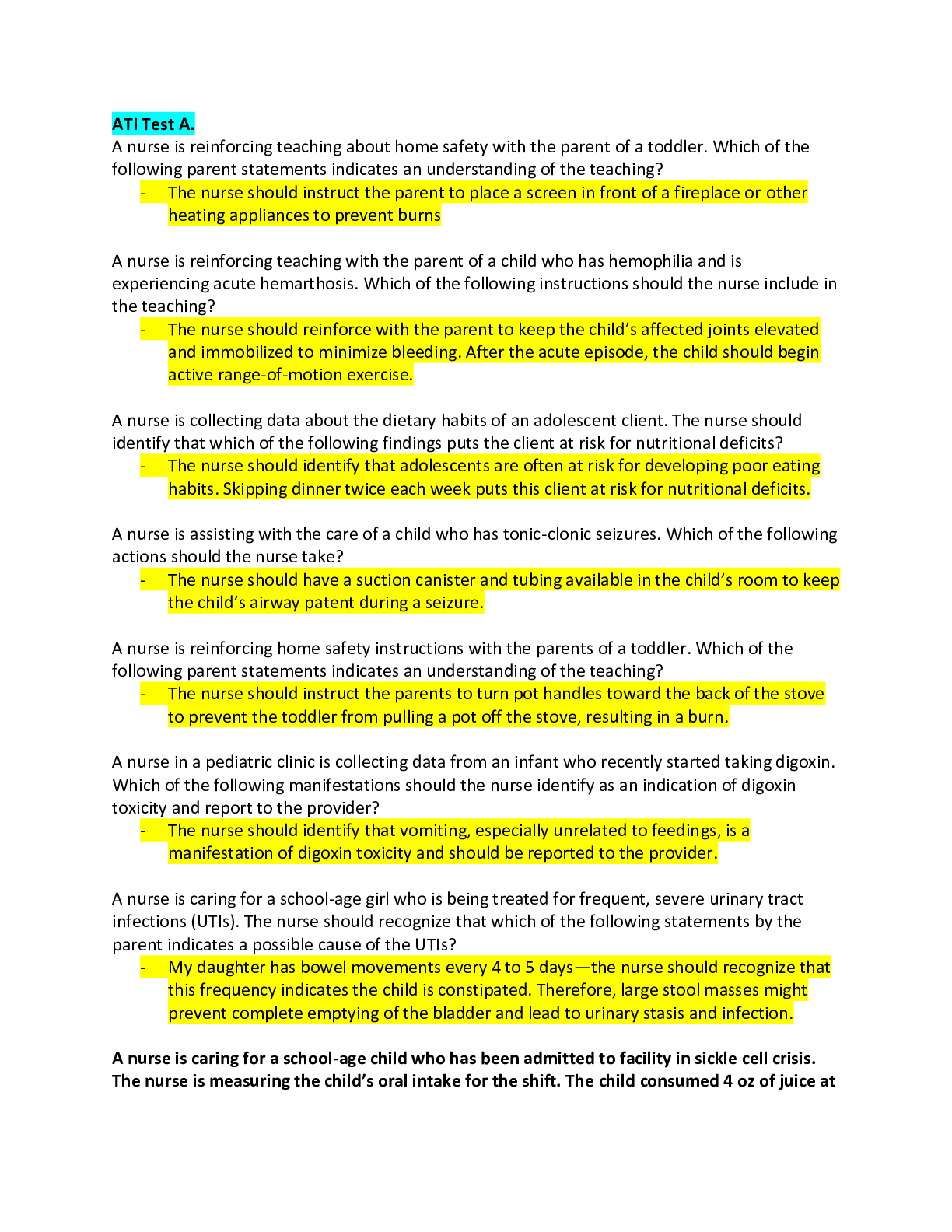
Buy this document to get the full access instantly
Instant Download Access after purchase
Buy NowInstant download
We Accept:

Reviews( 0 )
$11.00
Can't find what you want? Try our AI powered Search
Document information
Connected school, study & course
About the document
Uploaded On
Mar 22, 2021
Number of pages
8
Written in
All
Additional information
This document has been written for:
Uploaded
Mar 22, 2021
Downloads
0
Views
162

.png)
.png)
.png)
.png)
.png)
